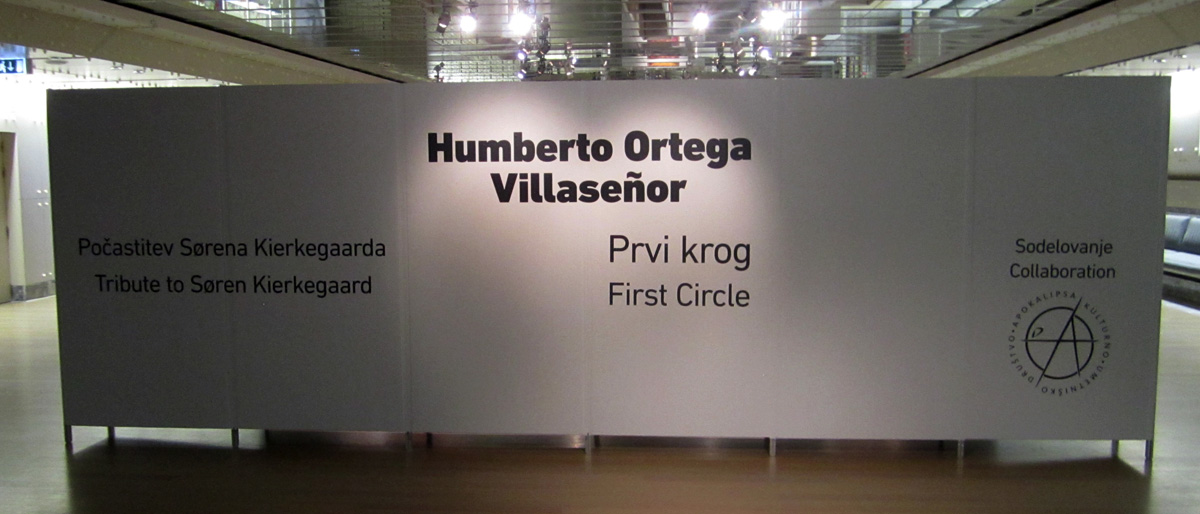Individual exhibition held at Cankarjev dom Cultural
and Congress Centre, Ljubljana, Slovenia.
The excerpts quoted here are from the Danish philosopher Soren Kierkegaard
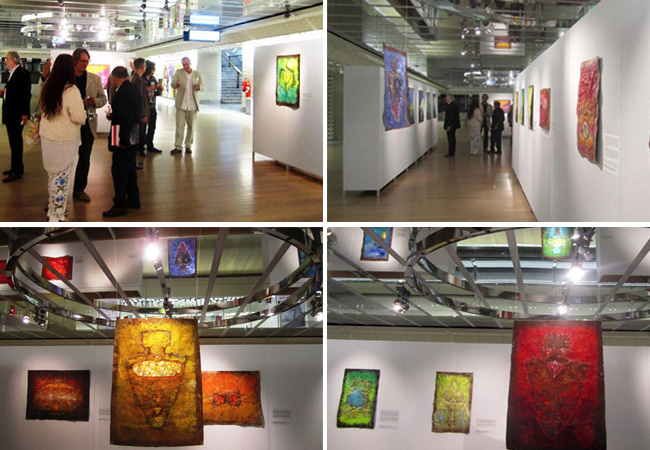
Multi-verse paradox, linking scales of light
Presentation of Pictorial Exhibition.
The Golden Section, number phi or divine proportion is a beautiful and elegant geometrical-mathematical ratio that effectively summarizes the laws governing aspects of proportion, rhythm and invariance found in all growing things (both animate and inanimate alike), i.e., in all evolving matter. A ratio that, as it unfolds, marks the involution and death of all life processes.
This formula achieved the status of fundamental knowledge underlying all reality in different ancient civilizations, as evidenced by numerous cultural manifestations of capital importance in the fields of architecture, painting, music, poetry and performing arts in many cultures throughout the world and over the centuries. In recent times, however, this knowledge has been relegated to the sidelines, a marginal or secondary topic of Art History or Aesthetics.
And yet the Golden Section deserves to recover its rightful place among contemporary scientists, due to the practical implications it seems to offer in fields of fundamental knowledge such as Astronomy and Physics. The discoveries made by these two frontier sciences in recent years are impressive, and have given rise to intriguing models of the Universe and theoretical postulations that attempt to explain reality in a comprehensive way, from its own perspective. Nevertheless, these contributions to knowledge have not managed to overcome their partial, fragmentary nature due to the lack of correspondence between the models that try to make sense of discoveries and events taking place on a cosmic level, and those coming out of microphysics. In other words, what astronomers see in the skies cannot be reconciled with observations made at the micro level, and vice versa: phenomena at the subatomic level cannot be scientifically proven at a macro scale. And this is inadmissible.
The formula of the Golden Section, on the other hand, manages to account for the development and decrepitude of all beings moving within the ineluctability of their own time, their own life cycle (ranging from systems of galaxies and stellar bodies to subatomic systems and particles). This dynamic postulation, which seems to synthesize the laws of Nature and that therefore may be called the Natural Model, casts a wide net, and could be an antidote to the dispersion of so many valuable contributions made by physicists, linking them to discoveries from other fields of frontier sciences such as Astronomy.
This small pictorial exhibition is made up of 9 pairs of abstract paintings that seek to concelebrate this finding. Thus, the criterion use for dividing planes, layout and chromatic shifts in each pair is resolved through recourse to the Golden Section. The units of each series represent a specific cosmic event linked to another event at the subatomic level. Even though they take place at different dimensions or scales of reality, macro and micro reveal similarities or complementarity precisely due to the underlying connection of the Golden Section. The 20 paintings measure 60/40 cm, and were created with a mixed technique of spatula on hand-made amate paper.
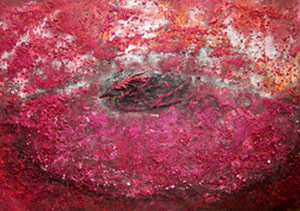
“Consciousness”,
40-60 cm, oil on amate, 2012
“If there were no eternal consciousness in man, […] if a bottomless abyss, impossible to fill, lurked behind everything, what else could existence be but hopelessness?” Fear and Trembling, Penguin Books, 2006
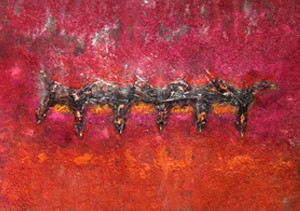
“Love swallow”,
60-80 cm, oil on amate, 2012
“A swallow in love with a young maiden could recognize the girl (because she is distinct from all the others), but the maiden could never distinguish the swallow from among one hundred thousand swallows. Imagine its wretchedness upon returning in the spring, saying, “It’s me,” and the maiden answering, “I don’t recognize you.” Diary, Kensington Publishing, 1988.
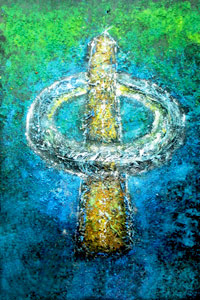
“Hallmark of the singular”,
60-40cm, oil on amate, 2012
“The greater the difference, the greater the individuality, the greater the distinctive features and the greater the recognizable traits. In this deep sense […] the notion of the soul, the distinctive feature of individuality, takes on deeper meaning.” Diary, Kensington Publishing, 1988.
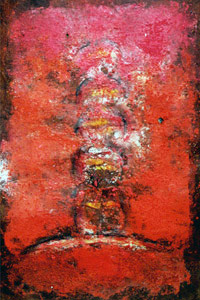
“Deep love”,
60-40cm, oil on amate, 2013
“There is no love more free than the loving act of remembering the departed… This act is the “most faithful” demonstration of love.” Diary, Kensington Publishing, 1988.
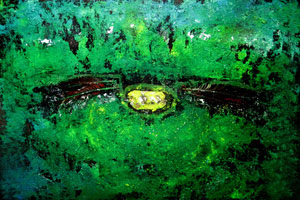
“Immutable love”,
60-80cm, oil on amate 2013
“If you truly love a person who has died, then remember him lovingly and you will have no reason to fear. In this way you will learn the wisdom of thought, the precision of expression, the strength of invariability, and the authentic pride of life.” Works of Love, Princeton University Press, 1998.
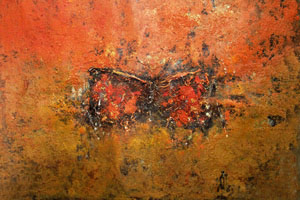
“Fragile sight”,
60-80cm, oil on amate 2013
“Our duty is to love the people we do not see, but also those we do see. If death separates us from the people we see, that is no reason for the love we owe them to cease. This duty is eternal.” Works of Love, 1847, Princeton University Press, 1998.
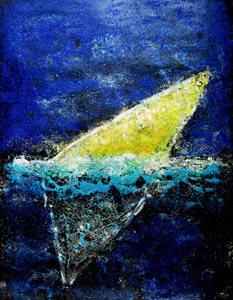
“Sea of eternity”,
80-60 cm, oil on amate 2013
“Wretched chance! I challenge you to a duel. Why do you not show yourself? Or is it that the universe’s agitation has been soothed and your enigma has been solved, and you have thrown yourself into the sea of eternity as well? I do not wish to defeat you, I only wish to raise you to the heights of poetry!” “The Seducer’s Diary”, in Either /Or, Part I, Princeton University Press, 1997.
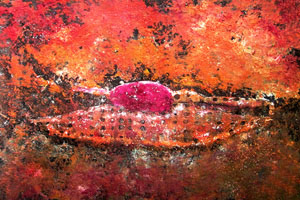
“Affordable skyline”,
60-80cm, oil on amate 2013
“It is about understanding my destiny, discovering that which God wants of me, finding a truth that is such “for me”. Extract from the letter that Kierkegaard wrote to Danish naturarist W. Lund (1801-1880), in 1835, Kierkegaard’s Writings, XXV: Letters and Documents, H. Rosenmeier, editor and translator, 2009.
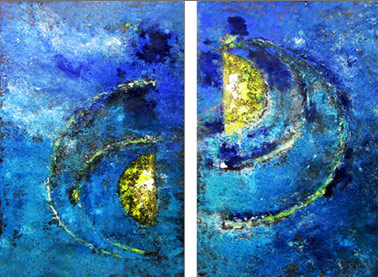
“Unpredictable random”,
80-60cm, oil on amate 2013
“I possess nothing, and I wish to possess nothing. I love nothing and I have nothing to lose, but this did not make me worthier of you, of you who have long grown weary of snatching away from people what they most love, weary of their cowardly moans, of their cowardly pleas”. “The Seducer’s Diary”, in Either /Or, Part I, Princeton University Press, 1997.
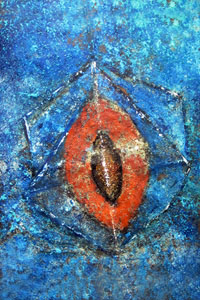
“Impossible possibility”,
80-60 cm, oil on amate 2013
“It is about understanding my destiny, discovering that which God wants of me, finding a truth that is such “for me”. Extract from the letter that Kierkegaard wrote to Danish naturarist W. Lund (1801-1880), in 1835, Kierkegaard’s Writings, XXV: Letters and Documents, H. Rosenmeier, editor and translator, 2009.
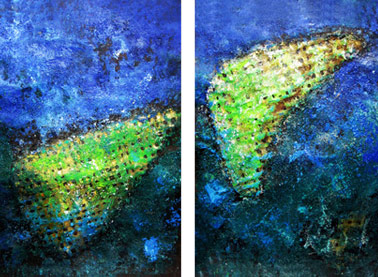
“One around the other”,
80-60 cm, oil on amate 2013
“What joy can there be in a love that does not demand the absolute self-abandonment of at least one of the parties? This truly calls for spirit… He would do better not to fall like a heavy body, but like a spirit gravitating around the other…” “The Seducer’s Diary”, in Either /Or, Part I, Princeton University Press, 1997.
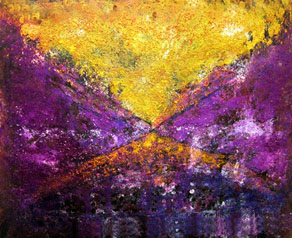
“Kisses”,
80-60 cm, oil on amate 2013
“Kisses can be divided by their sound; there are noisy ones, resonant ones; some explode, some grumble, some detonate, some sigh. There are sticky ones, gloomy ones and soft ones, as immense as silk…” “The Seducer’s Diary”, in Either /Or, Part I, Princeton University Press, 1997.
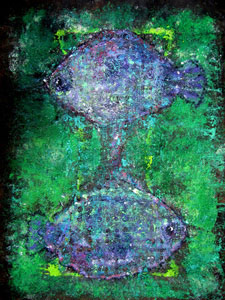
“One around the other”,
80-60 cm, oil on amate 2013
“What joy can there be in a love that does not demand the absolute self-abandonment of at least one of the parties? This truly calls for spirit… He would do better not to fall like a heavy body, but like a spirit gravitating around the other…” “The Seducer’s Diary”, in Either /Or, Part I, Princeton University Press, 1997.
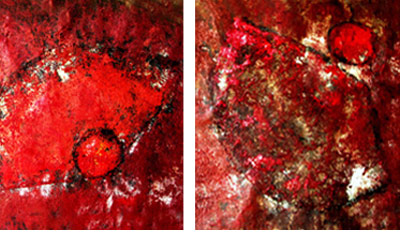
“Kisses”,
80-60 cm, oil on amate 2013
“Kisses can be divided by their sound; there are noisy ones, resonant ones; some explode, some grumble, some detonate, some sigh. There are sticky ones, gloomy ones and soft ones, as immense as silk…” “The Seducer’s Diary”, in Either /Or, Part I, Princeton University Press, 1997.
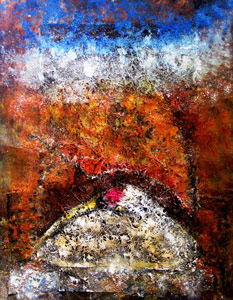
“Eternity”,
80-60 cm, oil on amate 2013
“Eternity, in spite of everything, will shine a light on despair… Then man will discover all the illusion there was in his belief in having fulfilled himself”. Sickness Unto Death, Princeton University Press, Princeton, New Jersey, 1941.
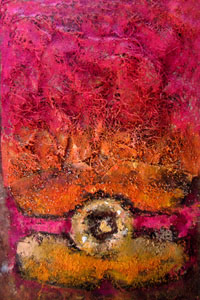
“Independent existence”,
60-40 cm, oil on amate 2013
“Whoever lacks an inner center of gravity will not stay afloat during the tempests of life. Only when man has understood himself in this way will he be able to lead an independent existence and avoid going astray”. Extract from the letter that Kierkegaard wrote to Danish naturarist W. Lund (1801-1880), in 1835, Kierkegaard’s Writings, XXV: Letters and Documents, H. Rosenmeier, editor and translator, 2009.
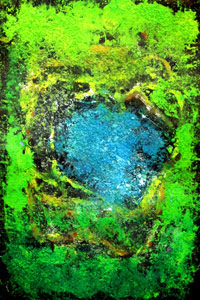
“Translucent seed”,
60-40 cm, oil on amate 2013
“I have tried, with all the respect that its importance deserves, to safeguard my individuality.(…) The interference of the common man has left me little in the way of profits or losses”. Extract from the letter that Kierkegaard wrote to Danish naturarist W. Lund (1801-1880), in 1835, Kierkegaard’s Writings, XXV: Letters and Documents, H. Rosenmeier, editor and translator, 2009…
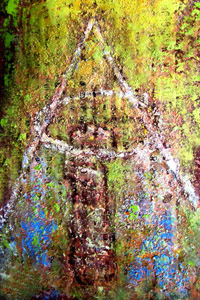
“Crystallizing”,
60-40 cm, oil on amate 2013
“The ego is the conscious synthesis of infinitude and finitude that relates to itself. This is something that can be verified only by relating to God”. La enfermedad mortal, Sarpe, Madrid, 1984.
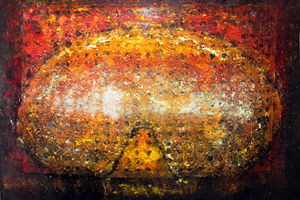
“Endless”,
60-80 cm, oil on amate 2013
“The passion of infinitude is precisely subjectivity, and thus, subjectivity is truth.” “Postilla conclusiva non scientifica alle Briciole di filosofia”, en Kierkegaard. Obras, editado por Cornelio Fabro, Sansoni, Firenze 1972.
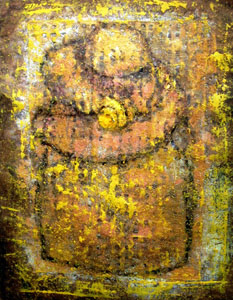
“Truth”,
80-60 cm, oil on amate 2013
“Truth is objective uncertainty maintained in the appropriation of the most passionate innerness, and this is the greatest truth that can ever be forthcoming in an existing person” “Postilla conclusiva non scientifica alle Briciole di filosofia”, en Kierkegaard. Obras, editado por Cornelio Fabro, Sansoni, Firenze 1972.
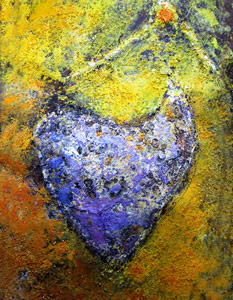
“Endearing faith”,
60-40 cm, oil on amate 2013
“Without risk there is no faith. Faith is precisely the contradiction between the infinite passion of innerness and objective uncertainty. If I were capable of attaining God objectively, then I would not believe; but since I cannot, I must believe.” “Postilla conclusiva non scientifica alle Briciole di filosofia”, en Kierkegaard. Obras, editado por Cornelio Fabro, Sansoni, Firenze 1972.
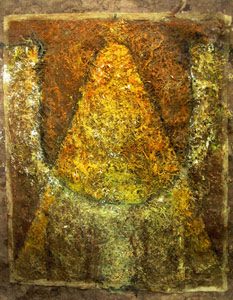
“Infinite self”,
80-60 cm, oil on amate 2013
The person undergoing hermetic despair, occupied in relating his own ego to himself, continues to live, successively, a few hours which, while not lived in themselves for eternity, do partake of it in some small way. The bad thing is that our despairing man is stuck there. La enfermedad mortal, (traducción de Demetrio G. Rivero), Sarpe, Madrid 1984.
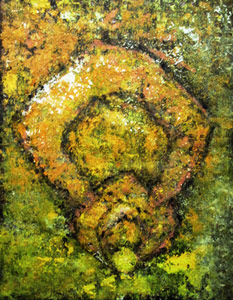
“Test”, 80-60 cm,
oil on amate 2013
Our earthly existence is a test about imitating the model. «Being a man, living in this world, means being tested, and life is a test. Esercizio del Cristianesimo, Studium, Roma 1971.
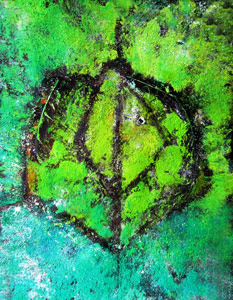
“Love, 80-60 cm”,
oil on amate 2013
Love covers the multitude of sins, because love keeps sin from emerging, smothering it at the moment of its birth. Las obras del amor : Meditaciones cristianas en forma de discursos, Ediciones Sígueme, Salamanca, 2006.
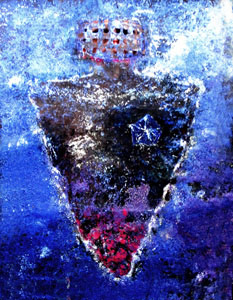
“Denial of truth”,
80-60 cm, oil on amate 2013
“There are two ways to be fooled. One is to believe what isn’t true; the other is to refuse to believe what is true.” Las obras del amor : Meditaciones cristianas en forma de discursos, Ediciones Sígueme, Salamanca, 2006.
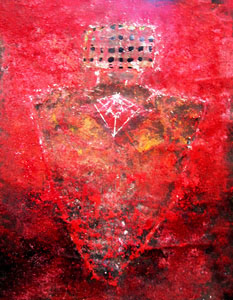
“Affirmation of falsehood”,
80-60 cm oil on amate 2013
“There are two ways to be fooled. One is to believe what isn’t true; the other is to refuse to believe what is true.” Las obras del amor : Meditaciones cristianas en forma de discursos, Ediciones Sígueme, Salamanca, 2006.
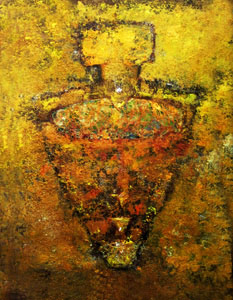
“Past”,
80-60 cm, oil on amate 2013
“It is perfectly true, as philosophers say, that life must be understood backwards. But they forget the other proposition, that it must be lived forwards.” Fear and Trembling/Repetition, Princeton University Press, 1983.
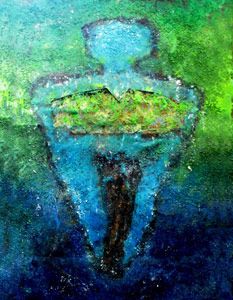
“Future”,
80-60 cm, oil on amate 2013
“It is perfectly true, as philosophers say, that life must be understood backwards. But they forget the other proposition, that it must be lived forwards.” Fear and Trembling/Repetition, Princeton University Press, 1983.
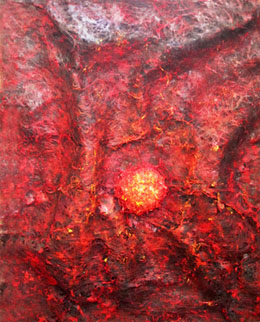
“Universe, the first circle”,
75-60 cm, oil on amate 2013
“Where am I? Who am I? How did I come to be here? What is this thing called the world? How did I come into the world? Why was I not consulted? And If I am compelled to take part in it, where is the director? I want to see him.” La repetición, Alianza Editorial, Madrid, c1843, 2009..
